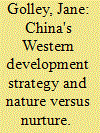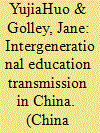|
|
|
Sort Order |
|
|
|
Items / Page
|
|
|
|
|
|
|
| Srl | Item |
| 1 |
ID:
080152


|
|
|
|
|
| Publication |
2007.
|
| Summary/Abstract |
The current trend of rising inequalities in industrial development between East and West China has resulted from a combination of nature and nurture. Given the natural tendency for firms to agglomerate in a developing, market economy, and the numerous geographical and historical factors that have long favoured the Eastern region, it is hardly surprising that this is where Chinese industry has become increasingly agglomerated in recent decades. It is even less surprising in light of deliberate policy choices that compounded, or nurtured, this natural tendency. Left to market forces alone, the agglomeration process should reverse itself (to some extent) in the (very) long-run, as firms relocate to provinces with relatively low costs of production. However, that theoretical long-run is too far away for the Chinese central government, which has introduced a 'Western Development Strategy' to try and speed up economic development in China's poorest region. This paper assesses the likelihood that this Strategy in its current guise will succeed in promoting industrial development in the West.
|
|
|
|
|
|
|
|
|
|
|
|
|
|
|
|
| 2 |
ID:
110502


|
|
|
|
|
| Publication |
2011.
|
| Summary/Abstract |
Many recent studies claim that China has reached a Lewisian 'turning point' in economic development, signalled by rising wages in urban areas and the exhaustion of rural surplus labour. In this paper we show that despite some evidence of rising nominal urban unskilled wages between 2000 and 2009, there is little in the data to suggest that this wage increase has been caused by unskilled labour shortages. China still has abundant under-employed workers with very low income in the rural sector. We argue that China's unique institutional and policy-induced barriers to migration have both prevented many rural workers from migrating to cities and also reduced the migrants' length of stay. We project that under alternative institutional settings, the migrant stock could easily be doubled from the current 150 million to 300 million by increasing either the average length of migrant stay, or the migrant inflow, or both.
|
|
|
|
|
|
|
|
|
|
|
|
|
|
|
|
| 3 |
ID:
119156


|
|
|
|
|
| Publication |
2013.
|
| Summary/Abstract |
This paper investigates trends in intergenerational patterns of educational attainment of those born in China between 1941 and 1990. Employing the 2008 Rural-Urban Migration in China and Indonesia Survey, we find that intergenerational correlation is lower in rural and migrant than in urban populations. The higher mobility observed in rural and migrant populations stems from the fact that the majority of these children complete only junior high school, with some children in the youngest cohorts moving down the education ladder relative to their parents. In contrast, urban children seem to at least maintain their parents' education level. The persistence of intergenerational transmission of education at high levels in urban areas combined with some mobility, upward or downward, in rural areas is likely to aggravate China's rural-urban disparity. Policies should focus more on the underlying gaps in education opportunities and the improvement in education of the rural and migrant populations.
|
|
|
|
|
|
|
|
|
|
|
|
|
|
|
|
| 4 |
ID:
161876


|
|
|
|
|
| Summary/Abstract |
This paper investigates trends in educational inequality in China, focusing on the contribution of ‘inequality of opportunity’ to these trends. Utilising the China Family Panel Studies survey for 2010 and 2012, we measure the inequality in individual educational outcomes (measured in years of schooling) in aggregate and for each of ten birth cohorts. We run regressions to identify the key determinants of these outcomes, all of which can be classified as ‘circumstances’ that lie beyond the control of each individual, and which reveal important variations in the magnitude and significance of key determinants across birth cohorts. The results are then used to calculate the share of ‘inequality of opportunity’ in overall educational inequality. The lack of equal opportunity for Chinese people with regard to their educational outcomes is shown to stem primarily from the divisive hukou system, with further significant contributions from father's education, birth cohort, province, parents' Communist Party membership, gender, family size and ethnicity, in that order.
|
|
|
|
|
|
|
|
|
|
|
|
|
|
|
|
| 5 |
ID:
164719


|
|
|
|
|
| Summary/Abstract |
This paper investigates the inequality of opportunity in China's labor earnings, defined as the component of inequality determined by personal circumstances that lie beyond the control of an individual, of which gender is one, as opposed to the component determined by personal efforts. Using the Survey of Women's Social Status in China (2010), we measure the share of inequality of opportunity in the total inequality of individual labor earnings for people aged 26–55 years, and separately for six birth cohorts and for female and male subsamples. Gender is revealed as the single most important circumstance determining nationwide individual labor earnings, with one's region of residence, father's occupation, father's education, birth cohort and holding rural or urban hukou also playing significant roles. A further investigation into the roles of circumstances and personal efforts (including education level, occupation, Communist Party membership, migration and marital status) confirms that circumstances play an alarmingly high role in shaping labor earnings distribution in China, and reveals notable gender differences that cannot be attributed to personal effort alone. These results provide the basis for recommending ways to improve gender equality of opportunity in the future.
|
|
|
|
|
|
|
|
|
|
|
|
|
|
|
|
| 6 |
ID:
187800


|
|
|
|
|
| Summary/Abstract |
This paper explores gender differences in intergenerational patterns of education attainment in China. Using the China Family Panel Studies (CFPS) survey for 2016, we find that intergenerational ‘persistence’, as reflected in high regression and correlation coefficients between an individual's and their parents' education levels, is higher for females than males for the entire sample and for each of four age cohorts. This result stems primarily from the relative lack of upward mobility among females from families with low levels of education, as confirmed by a series of educational mobility matrices and a multinomial logistic regression analysis. The results offer novel insights into gender differences in the unequal transmission of education across generations, with significant implications for gender inequality more broadly in Chinese society.
|
|
|
|
|
|
|
|
|
|
|
|
|
|
|
|
| 7 |
ID:
143386


|
|
|
|
|
| Summary/Abstract |
This paper focuses on two major elements of China's population dynamics—the rising proportion of workers in the population and the shift of rural workers from agriculture into industry and services—in a provincial-level analysis of per capita income and productivity growth during the last three decades. We measure the ‘mechanical’ contributions of these dynamics to per capita income as revealed by growth decompositions, before assessing the determinants of per capita income and productivity growth in a series of regressions that include the growth of the working-age to total population (WAP) ratio and a measure of sectoral employment change. Our results indicate that sectoral change has made a significant positive contribution to both per capita income growth and aggregate productivity growth, stemming from its positive impact on agricultural productivity growth—as predicted by the Lewisian dual economy model. However, the negative impact of sectoral change on productivity growth in the industrial and service sectors, combined with the negative impact of growth of the WAP ratio on both per capita income and aggregate productivity growth, suggests that the benefits of China's population dynamics during the last three decades have been overstated.
|
|
|
|
|
|
|
|
|
|
|
|
|
|
|
|
|
|
|
|
|